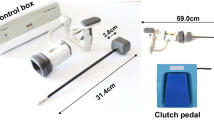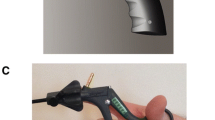Abstract
Purpose
To facilitate effective and efficient training in skills laboratory, objective metrics can be used. Forces exerted on the tissues can be a measure of safe tissue manipulation. To provide feedback during training, expert threshold levels need to be determined. The purpose of this study was to define the magnitude and the direction of navigation forces used during arthroscopic inspection of the wrist.
Methods
We developed a set-up to mount a cadaver wrist to a 3D force platform that allowed measurement of the forces exerted on the wrist. Six experts in wrist arthroscopy performed two tasks: (1) Introduction of the camera and visualization of the hook. (2) Navigation through the wrist with visualization of five anatomic structures. The magnitude (Fabs) and direction of force were recorded, with the direction defined as α being the angle in the vertical plane and β being the angle in the horizontal plane. The 10th–90th percentile of the data were used to set threshold levels for training.
Results
The results show distinct force patterns for each of the anatomic landmarks. Median Fabs of the navigation task is 3.8 N (1.8–7.3), α is 3.60 (−54–44) and β is 260 (0–72).
Conclusion
Unique expert data on navigation forces during wrist arthroscopy were determined. The defined maximum allowable navigation force of 7.3 N (90th percentile) can be used in providing feedback on performance during skills training. The clinical value is that this study contributes to objective assessment of skills levels.





Similar content being viewed by others
References
Atzei A, Luchetti R, Sgarbossa A, Carità E, Llusà M (2006) Set-up, portals and normal exploration in wrist arthroscopy. Chir Main 25(Suppl 1):S131–S144
Chami G, Ward J, Wills D, Philips R, Sherman K (2006) Smart tool for force measurements during knee arthroscopy: in vivo human study. Stud Health Technol Inform 119:85–89
Chmarra MK, Bakker NH, Grimbergen CA, Dankelman J (2006) TrEndo, a device for tracking minimally invasive surgical instruments in training setups. Sens Actuators A Phys 126:328–334
Chmarra MK, Grimbergen CA, Dankelman J (2007) Systems for tracking minimally invasive surgical instruments. Minim Invasive Ther Allied Technol 16:328–340
Haisman JM, Bush M, Wolfe S (2005) Wrist arthroscopy: standard portals and arthroscopic anatomy. J Am Soc Surg Hand 5(3):175–181
Hui Y, Safir O, Dubrowski A, Carnahan H (2013) What skills should simulation training in arthroscopy teach residents? A focus on resident input. Int J Comput Assist Radiol Surg 8(6):945–953
Hofstad EF, Vapenstad C, Chmarra MK, Lango T, Kuhry E, Marvik R (2013) A study of psychomotor skills in minimally invasive surgery: what differentiates expert and nonexpert performance. Surg Endosc 27(3):854–863
Horeman T, Rodrigues SP, van den Dobbelsteen JJ, Jansen FW, Dankelman J (2012) Visual force feedback in laparoscopic training. Surg Endosc 26(1):242–248
Horeman T, Rodrigues SP, Jansen FW, Dankelman J, van den Dobbelsteen JJ (2012) Force measurement platform for training and assessment of laparoscopic skills. Surg Endosc 26(4):1005–1009
Horeman T, van Delft F, Blikkendaal MD, Dankelman J, van den Dobbelsteen JJ, Jansen F-W (2014) Learning from visual force feedback in box trainers: tissue manipulation in laparoscopic surgery. Surg Endosc 28:1961–1970
Horeman T, Dankelman J, Jansen FW, van den Dobbelsteen JJ (2014) Assessment of laparoscopic skills based on force and motion parameters. IEEE Trans Biomed Eng 61(3):805–813
Horeman T, Blikkendaal MD, Feng D, van Dijke A, Jansen F, Dankelman J, van den Dobbelsteen JJ (2014) Visual forces feedback improves knot-tying security. J Surg Educ 71(1):133–141
Mabrey JD, Reinig KD, Cannon WD (2010) Virtual reality in orthopaedics: is it a reality? Clin Orthop Relat Res 468:2586–2591
Modi CS, Morris G, Mukherjee R (2010) Computer-simulation training for knee and shoulder arthroscopic surgery. Arthroscopy 26:832–840
Obdeijn MC, Bavinck N, Mathoulin C, van der Horst CM, Schijven MP, Tuijthof GJ (2013) Education in wrist arthroscopy: past, present and future. Knee Surg Sports Traumatol Arthrosc 9 [Epub ahead of print]
Obdeijn MC, van Baalen SJ, Horeman T, Liverneaux P, Tuijthof GJ (2014) The use of navigation forces for assessment of wrist arthroscopy skills. J Wrist Surg 3(2):132–138
Richards C, Rosen J, Hannaford B, Pelligrini C, Sinanan M (2000) Skills evaluation in minimally invasive surgery using force/torque signatures. Surg Endosc 14:791–798
Rodrigues SP, Horeman T, Dankelman J, van den Dobbelsteen JJ, Jansen FW (2010) Suturing intraabdominal organs: when do we cause tissue damage? Surg Endosc 24:3102–3108
Shore EM, Lefebvre GG, Grantcharov TP (2014) Gynecology resident laparoscopy training: present and future. Am J Obstet Gynecol 25: doi: 10.1016//ajog2014.07.039 (Epub ahead of print)
Tashiro Y, Miura H, Nakanishi Y, Okazaki K, Iwamoto Y (2009) Evaluation of skills in arthroscopic training based on trajectory and force data. Clin Orthop Relat Res 467:546–552
Tuijthof GJM, Horeman T, Schafroth MU, Blankevoort L, Kerkhoffs GMMJ (2011) Probing forces of menisci: what levels are safe for arthroscopic surgery? Knee Surg Sports Traumatol Arthrosc 19:248–254
Van Hove PD, Tuijthof GJ, Verdaasdonk EG, Stassen LP, Dankelman J (2010) Objective assessment of technical surgical skills. Br J Surg 97:972–987
Acknowledgments
The authors would like to thank the experts who participated in this study. Furthermore, we would like to thank Storz for supplying the instruments and arthroscopy camera for the measurements, and the personnel of the IRCAD laboratories for their kind cooperation during the study.
Conflict of interest
Dr. Obdeijn and Tuijthof and Ms. de Boer and van Baalen have no conflicts of interest or financial ties to disclose. Tim Horeman works as a PhD. researcher at the TU Delft and is partly involved as director of technology and organization at MediShield BV. The ForceTRAP was developed in collaboration between Medishield and the MISIT lab of TU Delft only for non-commercial purposes and was modified for the present study on request. Dr. Liverneaux is a consultant for Newclip Technics, SBI, Argomedical and Integra. None of the authors received financial support for this study.
Author information
Authors and Affiliations
Corresponding author
Rights and permissions
About this article
Cite this article
Obdeijn, M.C., Horeman, T., de Boer, L.L. et al. Navigation forces during wrist arthroscopy: assessment of expert levels. Knee Surg Sports Traumatol Arthrosc 24, 3684–3692 (2016). https://doi.org/10.1007/s00167-014-3450-2
Received:
Accepted:
Published:
Issue Date:
DOI: https://doi.org/10.1007/s00167-014-3450-2




